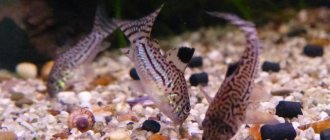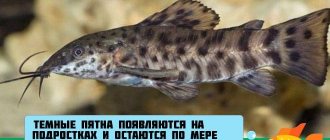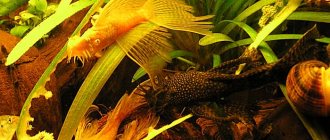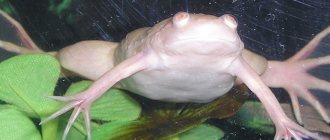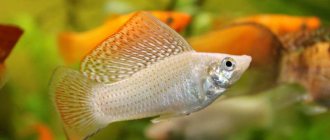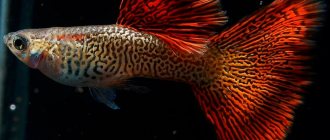Red-tailed catfish (Phractocephalus hemioliopterus, fractocephalus, pyrarara, river monster, flathead).
The amazing and often shocking nature of the Amazon River Valley is so rich in interesting species of living creatures that it would take years and many hundreds of kilograms of paper covered in small handwriting to describe even a tenth of the fauna living there - this unique corner of our planet is so diverse and attractive.
One of the representatives of the underwater fauna of those places will be discussed in this article. About the fish, which the Peruvians call pirarara, and the inhabitants of Venezuela - cajaro, about the red-tailed catfish fractocephalus , the genus of which dates back about twenty million years (early Miocene era, Neogene period). This fish is also called river monster, flathead, Orinoco catfish. Today, the red-tailed catfish is the only species of its kind, preserved from the times of ancient lizards, included in the international classification in 1801 (Phractocephalus hemioliopterus, Bloch & Schneider), has become one of the most unusual inhabitants of private aquariums around the world, however, about everything in order…
Redtail catfish photo
Have we all heard the catchphrase “dumb as a fish” more than once? So forget it! Not all fish are mute. Some may be “laconic”, but they are capable of making sounds, sometimes frightening and quite loud. The red-tailed catfish is often called the “screaming fish” by the indigenous people of the Amazon for one of its features - the fractocephalus makes a very loud trumpet sound, carried hundreds of meters, similar to the roar of an elephant. Although the pirarara does not have vocal cords, it successfully uses tightly closed gills through which it passes a mixture of water and air, scaring off unwanted guests or predators. Oh yes! I forgot to say that the red-tailed catfish is not a small fish, reaching in its natural habitat a length of up to two meters and a weight of eighty kilograms, however, such giants are extremely rare.
One and a half meter and fifty kilogram specimens are more often described, which, however, does not in any way detract from the significance of their dimensions. At the same time, the flathead catfish will snatch its first rightful half-meter of length from nature in just a year of its long life for fish (almost 20 years!). The body is elongated, powerful, the head is large, wide, flattened, the mouth is large... no, not like that. The mouth is HUGE. The muzzle is topped with three pairs of whiskers. The color of the back is dark, almost black, the belly and sides are contrastingly light, but the nature of the Amazon does not like monochrome, so Fractocephalus received a bright orange caudal fin and the same edging of the dorsal fin, which radically changed the neutral color of this fish.
Fractocephalus is a large predatory representative of the catfish order with pronounced territorial claims. Under the mask of the phlegmatic nature inherent in catfish, there is hidden a cocked spring, ready to break loose for a lightning-fast rush for prey in the form of a gaping fish, a reptile, a mollusk... and anything that fits into the mouth, and a lot will fit! A fish or reptile that is only half as large as the river monster Pirarara is already an obvious catch. He will think a little about an object that is one third smaller than the flathead and is also unlikely to refuse to try. Fractocephalus prefers to live and hunt in the bottom layer of water, from ambush, in the dark. It is difficult to call the red-tailed catfish aggressive, since its aggression is either aimed at territorial disputes with representatives of its own species, or it is mistaken for the desire of the flathead to satisfy its hunger at the expense of smaller representatives of the river fauna. Despite all the monstrousness described above, the red-tailed catfish is very shy and prefers most of the time to lie motionless in a shelter, pretending to be an old log, away from eyes and bright light. Moreover, the older the individual, the more time it spends in a state of complete rest, especially if this individual is well-fed, which, however, is rare - the pyrarara is phenomenally gluttonous.
General information
The red-tailed catfish, or fractocephalus, is a large predatory fish that lives in the hot climate of South America and the Amazon River Valley. In natural conditions it reaches truly enormous sizes, up to 1.8 meters. The weight of an adult reaches 80 kg.
There are cases when adult catfish dragged small mammals and birds that came to drink from the shore. There are also legends among local residents that such a monster, if desired, can drag away a child.
But let's not delve into folklore. In the modern world, despite its size, Fractocephalus is popular among aquarium keepers. Of course, more often it is bought for buildings like zoos, but not always.
It should be noted that in the confined space of an aquarium, the catfish grows to a smaller size than in its natural environment. But despite this, he still needs a very large aquarium with a volume of from 300 liters to 6 tons so that he can move freely and not deny himself anything.
Habitat in nature
The red-tailed catfish lives in South America. It is also known under the names: and also: Orinoco catfish, flathead, fractocephalus. The red-tailed catfish lives in the Amazon, Orinoco and Essequibo river basins of South America, Ecuador, Venezuela, Guyana, Colombia, Peru, Suriname, Bolivia and Brazil. It is found only in fresh water and inhabits larger rivers, streams and lakes. In local dialects it is called pirarara and cajaro.
It lives in South America in the Amazon, Orinoco and Essequibo. Residents of Peru call the red-tailed catfish - pirarara. In nature it reaches 80 kg and a body length of up to 1.8 meters, but nevertheless it is a very popular aquarium fish. The red-tailed catfish grows very large even in small aquariums.
Due to its enormous size, this catfish is a coveted trophy for many professional fishermen. The current IGFA world record belongs to the Brazilian Gilberto Fernandez, who caught a catfish weighing 56 kg. Although it is claimed that locals do not eat it because of the black color of the meat.
Is it worth getting a red-tailed catfish?
It is extremely rare to find this fish in home aquariums, since fractocephalus reaches enormous sizes and needs a reservoir of at least 7.5 tons of water, which is almost impossible to organize at home. Despite the fact that catfish will feel comfortable with neighbors of the same size, it is not possible to find similar fish, much less keep them.
Don’t be fooled by the “modest” size of young individuals. Fractocephalus grows very quickly. In just a few months they will grow to incredible sizes. Most often, red-tailed catfish are bred as a food product. Their meat is considered an exquisite delicacy.
The life cycle of catfish is about 20 years. If you still want to have such an unusual pet in an aquarium, you need to be prepared for great difficulties. A cramped aquarium and poor quality food are death for red-tailed catfish.
General acquaintance
The homeland of these beautiful and attractive fish is the basins of the largest rivers in South America - the Orinoco and the Amazon, where they lead a benthic lifestyle, constantly being at the bottom. Ichthyologists call such inhabitants demersal species.
In aquarium circles they are often called flatheads. There is also a third name - Orinoco, which is associated with the Orinoco River. Why is he a flathead? To answer this question, just look at its head, which is noticeably flattened on top.
This representative of the catfish order belongs to the family Pimelodidae or flat-headed catfishes. Its Latin name is Phractocephalus hemioliopterus, and it is currently recognized as the only member of the genus Phractocephalus. Therefore, there is a fourth name often used for it: fractocephalus. In Brazil, in the local dialect (Portuguese), the names used for flatheads are pirarara, huarara or pirarabebe.
Appearance
These beautiful representatives of catfish have a very bright, attractive appearance. For this reason, many hobbyists purchase them for home maintenance. Even the large size of this “aquarium fish” is not an obstacle to the growing popularity of fractocephals.
Of course, not every fish can boast such a colorful appearance:
- Big blue eyes on a huge flat head.
- A very wide mouth creates the feeling that its owner is constantly smiling.
- Three pairs of antennae surround the mouth: two pairs are located under the lower jaw (they are shorter) and the two longest antennae are located above the upper one.
- The oblong body is black and white and ends with a wide, bladeless caudal fin of reddish-orange color.
Phractocephalus hemioliopterus has no scales.
Adipose and other fins
Particular attention should be paid to the fins. The flathead is distinguished by the presence of a rather noticeable adipose fin located between the dorsal and caudal fin. The adipose fin is practically a “mirror image” of the anal fin, corresponding to it in size, color and location relative to the body. The dorsal fin is located in the center of the back, it is of medium length and quite high. In young individuals, it may have orange fragments in color and a white edging, which persists in adults.
How to keep a flathead
The red-tailed catfish in an aquarium looks unusually impressive, but the difficulty of keeping it is assessed as high. Since it is large, it is important to understand what size vessel you need to have or purchase. For juveniles, you can also use a small container - from 300 to 800 liters, depending on the size of the juveniles you purchased (5, 8 or 16 centimeters). But in a year your pet will be about half a meter. And for such a full-sized individual, you need an almost real pool with a volume of about 6 tons (6000 liters).
You can keep it in a smaller volume, which will limit the possibility of growth, and its size will correspond to the size of the home. But such a situation is highly undesirable because, deprived of the opportunity to grow normally, the red-tailed catfish will have health problems and may die a premature death.
Therefore, before you buy a small Orinoco catfish with a length of only 4 centimeters (and such young specimens are often sold at poultry markets), think about whether you can provide it with the appropriate volume when it grows up in a year.
Appearance
Fractocephalus looks quite interesting. It has a gray back with spots and a white belly. The body of the fish is oblong, the head is large and flat. Has 2 large eyes located on the sides.
Catfish have 3 pairs of whiskers. Two of them are located on the lower jaw of the fish, and one is located on top. What is noteworthy is that the third pair is much longer than the others.
The caudal fin is brightly colored from light orange to bright red. This is how the fish got its name.
It should be noted that Fractocephalus grows very quickly, so young individuals are usually kept in aquariums. It is noteworthy that such fish are also bred as a source of meat on farms, and their meat is considered very tasty.
Description
Fractocephalus is dark gray above with scattered black spots. A huge mouth, the same width as the body, the lower part of it is white. There is a pair of mustaches on the upper lip, and two pairs on the lower lip.
A white stripe runs from the mouth along the body to the tail and on the side it is gray-white. The caudal fin and the tip of the dorsal fin are bright orange.
The eyes are located high on the head, which is typical for a predator.
Phractocephalus hemioliopterus can reach about 1.8 m in length and weigh about 80 kg. However, this happens extremely rarely, and most of them reach an average of 3.5–1.1–1.4 m in length. Naturally, in an aquarium the catfish is even smaller and its size greatly depends on the size of the aquarium.
The lifespan of the red-tailed catfish is up to 20 years.
Feeding
The redtail catfish is an omnivore. Moreover, he is phenomenally gluttonous. He will happily eat whatever is given to him in any quantity. To avoid obesity and related diseases, it is necessary to strictly follow the feeding schedule and not overfeed the catfish. You can feed it anything, fish love and willingly eat all types of live, dry or frozen food, but fresh meat is an especially healthy and favorite option. Young fish can be fed with shrimp, bloodworms, squid, and finely chopped white fish fillets. It is recommended to feed adult individuals with raw capelin (it can be cut into pieces directly with the bones), small live fish, chicken heart or liver (not often, as an exception or treat).
Try to diversify your fish's diet; they tend to get used to one type of food and subsequently refuse others. Fracocetals quickly remember feeding times and always swim up to the glass in anticipation of food. These catfish are easily tamed and with very little effort you can easily train your aquarium pet not to be afraid of hands.
Aquarium fish. Description of aquarium fish species
IN
| Algaecides |
| Medications |
| Water preparation |
| Preparations for starting a biofilter |
| Water treatment systems and accessories for them |
| Tests |
| Plant care |
| Electronic systems for monitoring water parameters |
| Freshwater shellfish |
| Freshwater arthropods |
| Long-stemmed aquarium plants |
| Bush aquarium plants |
| Other aquarium plants |
| Atherinaeformes, splashers, argusaceae |
| Barbs, zebrafish, labeo |
| Goldfish, carps, loaches |
| Carp-toothed, viviparous |
| Labyrinths, snakeheads, proboscis snouts |
| Stingrays, lungfishes, armored |
| Catfish |
| Characins, piranhas, wedge-bellied |
| Cichlids of America, Asia and African rivers |
| Cichlids of lakes Malawi and Tanganyika |
| Anubias Aquariums |
| Aquariums |
| Aquatlantis aquariums |
| Ferplast aquariums |
| Juwel Aquariums |
| Red Sea Aquariums |
| Aquariums are different |
| Juwel Aquarium Sale |
| Cabinets |
| Compressors |
| Equipment for CO2 |
| Ozonizers |
| Oxidizers |
| Accessories and spare parts |
| Soils and stones |
| Aquarium decorations |
| Artificial corals and stones |
| Natural corals and shells |
| Natural driftwood |
| Plastic plants |
| Relief backgrounds |
| Aquarium background |
| Silk plants |
| Otsadniki |
| Other tools and accessories |
| Nets |
| Siphons |
| Scrapers |
| Hoses and tubes |
| Vitamins |
| Frozen food |
| Dry and special food |
| Feeders |
| Animal Book Atlases |
| Atlases Mergus |
| Aqualog atlases and posters |
| Literature in Russian |
| Literature on terrarium |
| Periodicals |
| Denitrifiers and fillers |
| Calcium reactors and fillers |
| Food for marine fish and invertebrates |
| Medicines for marine fish |
| Literature on marine aquarium keeping |
| Marine chemistry |
| Sea stones |
| Foam separators |
| Pumps and devices for various purposes |
| Sea salt |
| Marine filters |
| Sea anemones (Actiniaria) |
| Gastropods (Gastropoda) |
| Hydroid polyps (Hydroidea) |
| Cephalopods (Cephalopoda) |
| Holothurians (Holothuroidea) |
| Bivalves (Bivalvia) |
| Discoactinia (Corallimorpharia) |
| Stony corals, madrepore corals (Scleractinia) |
| Zoanthus (Zoanthiniaria) |
| Jellyfish (Scyphozoa) |
| Horseshoe crabs (Xiphosura) |
| Sea urchins (Echinoidea) |
| Starfish (Asteroidea) |
| Sea lilies (Crinoidea) |
| Sea worms (Polychaeta) |
| Soft corals (Alcyonacea) |
| Brittle stars (Ophiuroidea) |
| Crustaceans (Crustacea) |
| Ceriantharia |
| Curlyfins, stickfins, wrasse, parrotfish |
| Falsechromis, grams, plesiops, apogons, horse mackerel, red mullet, platax |
| Pomacanthaceae (Angelfish) |
| Pomacentrics, amphiprionics |
| Scorpionfishes, flounderfishes, rockfishes, anglerfishes |
| blenny, tangerines, gobies |
| Catfishes, Berixiformes, Sticklebacks, Groupers, Anthias |
| Surgical |
| Cartilaginous, eel-like, euryhaline |
| Bristletoothed (Butterfly fish) |
| Lighting accessories |
| Fluorescent lamps T5 (diameter 16 mm) |
| Fluorescent lamps T8 (diameter 26 mm) |
| Metal halide lamps |
| Lamps are different |
| Starters |
| Lamps |
| Metal halide lamps |
| LED lamps |
| Timers |
| Accessories and spare parts |
| Pond aeration |
| Pond fish food |
| Pond heaters |
| Pond film |
| Fish and plants for the pond |
| Pond lights |
| Pond tests |
| UV sterilizers for ponds |
| Pond filters and pumps |
| Pond chemistry |
| Spare parts and accessories for thermoregulation |
| Heaters |
| Aquarium thermometers |
| Refrigerators |
| Accessories for terrariums |
| Feed and vitamins |
| Lighting and heating |
| Preparations for reptiles |
| Terrariums |
| Amphibians |
| Terrestrial invertebrates |
| Live food for terrarium animals |
| Snakes |
| Turtles (Testudines) |
| Aquatic turtles (Emydidae) |
| Lizards (Sauria) |
| Lizards are different |
| Lizards. Agamidae family |
| Lizards. Iguana family (Iguanidae) |
| Aquarium UV sterilizers |
| External filters EHEIM |
| Internal filters and pumps |
| Filtration parts and accessories |
| Filter fillers |
| Other external filters |
Red-tailed catfish is one of the names of the fish of the Pimelodidae family, whose main habitat is the river expanses of South America. The article will talk specifically about this fish, which gets along well in large aquariums. You can also hear the following names for this fish:
- Fractocephalus.
- Orinoco catfish.
- Pirarara.
The size of an adult individual exceeds the meter mark . Such specimens are especially common in natural conditions. Its appearance is quite common for representatives of this family: the elongated body is crowned with a flat head. Therefore, it is sometimes called flathead. Nature has awarded the red-tailed catfish with three pairs of whiskers. Two of which are located on the lower jaw area and the third on the upper. The mustache is usually of impressive length. And the lower pairs are slightly longer.
Compatibility
Redtail catfish are an extremely popular fish in shows and public aquariums, where they are often housed with other large fish such as black pacu and other large catfish.
Even as juveniles only a few centimeters long, they are capable of swallowing many of the most common aquarium fish (such as blue neons or guppies), and it is only appropriate to house these fish with other relatively larger species.
Although the redtail catfish will hesitate to swallow any small fish, it is quite peaceful and can be kept with fish of equal size. True, this requires an aquarium, which you can hardly keep at home.
Most often it is kept with large cichlids, or with other catfish, such as tiger pseudoplatistoma.
Please note that the capabilities of catfish are often underestimated, and they eat fish that they seem unable to swallow.
They guard the territory and can be aggressive towards relatives or catfish of other species, so it is not worth (and hardly possible) keeping several adult individuals.
Content complexity
Although the description is intended to give you an idea of the contents, we strongly advise against keeping this fish unless you can afford a phenomenal sized aquarium.
The requirements for the aquarium described above are underestimated, and 2,000 liters is a more or less real figure. Abroad, catfish are kept in zoos...
Unfortunately, recently the red-tailed catfish has become more accessible and is often sold to unknowing people as a completely common species.
It quickly grows to gigantic sizes and aquarists do not know what to do with it. A common solution is natural bodies of water, and if it does not survive in our latitudes, it can become a problem for the United States.
Red-tailed catfish: keeping in captivity
Since the fish is a very voracious predator, it cannot be placed in the same aquarium with smaller neighbors, because it will simply eat them. However, it is also not recommended to keep her alone.
Large cichlids, other species of catfish and any fish that will not fit into its mouth will be excellent neighbors for the red-tailed catfish. Moreover, the possibility of eating your neighbor's fractocephalus should in no case be underestimated.
Catfish are predominantly nocturnal, so the aquarium must have shelters for daytime activities. Lighting must be diffused; catfish do not like bright light.
Coarse gravel and sand are suitable as soil. It is noteworthy that catfish like to burrow into shallow soil.
There should be no small unstable objects in the aquarium: a fish can use them to break or split its home by wagging its tail unsuccessfully.
The water temperature should always be kept within 22-28°C, moderate current, hardness 3-13 degrees, pH 5.5-7.2.
In an aquarium where the red-tailed catfish lives, aeration, daily water changes (due to the abundance of waste) and good water filtration are necessary.
If we talk about the character of Fractocephalus, it is quite slow and leads a predominantly bottom life. The older the individual, the less mobile it becomes.
Character and behavior
Red-tailed catfish are quite specific aquarium inhabitants with unusual habits:
- They are nocturnal, and prefer to spend daylight hours buried in the ground or hiding in a shelter.
- The character, despite the terrifying appearance, is quite calm and peaceful. Fish can be aggressive if someone decides to encroach on their territory. In this regard, it is not recommended to keep several adult individuals in one aquarium.
- They recognize the owner. When it appears near the aquarium, they will swim up to the glass, begging for food. They can take food directly from your hands.
- They make sounds similar to roars. A similar phenomenon occurs due to the expulsion of a mixture of air and water through closed gills.
Possible diseases
Red-tailed catfish are characterized by excellent, good health. The only thing he can get sick with is obesity, which develops as a result of poor nutrition and frequent feeding. This is a real problem for catfish, often leading to their death.
Due to poor nutrition, especially if the diet includes fresh meat or offal, dangerous digestive problems can occur. If the disease is not recognized in a timely manner, it will lead to dysfunction of all internal organs, and it will not be possible to save the catfish.
Reproduction and breeding
It is possible to get offspring from a red-tailed catfish at home only if you are the happy owner of a warm decorative pond with several tons of water. It is under these conditions that fish are bred in fish farms in Southeast Asia.
Cases of reproduction in aquarium conditions have not yet been recorded.
